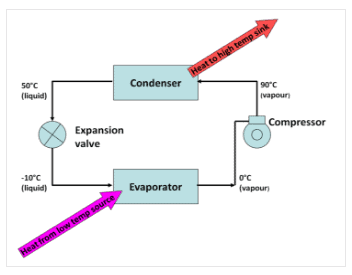How a Heat Pump Works.

How does a heat pump work?
The image below shows the basic components of a heat pump. The compressor is used to compress the refrigerant vapour and in doing so raises its temperature (typically from around
0°C to around 90°C). This hot vapour is then allowed to cool and as it passes through the condenser it gives up useful heat.

The expansion valve controls the flow of the refrigerant and allows its pressure and temperature to drop. The liquid refrigerant is then allowed to evaporate by absorbing heat from the source. The energy put into the compressor is regained several times over because of the process of evaporation and condensation: absorbing heat from the source as the refrigerant boils and giving up latent heat to the sink as the refrigerant condenses.
The performance of a heat pump is defined as the heat generated by the condenser compared to the electricity used in the compressor. This is called the coefficient of performance (CoP). The CoP is dependent on the temperature of the evaporator and condenser; the maximum theoretical CoP is given by:
Tc / (Tc-Te), where Tc is the condenser temperature and Te is the evaporator temperature both measured in Kelvin (K).
The CoP for the schematic above would be: 343 K / (343 K – 268 K) = 4.6
Average condenser temp = (90+50)/2 = 70°C; 273 K + 70°C = 343 K
Average evaporator temp = (-10+0)/2- 5°C; 273 K – 5°C = 268 K
(The actual CoP will be considerably less than this theoretical figure.)
Now say we can reduce the condenser temperature by 20 K by using a low temperature sink (e.g. underfloor heating) and we can increase the temperature of the evaporator by 5 K, exploiting the low grade heat in the ground. In this case the theoretical CoP would be:
323 K / (323 K – 273 K) = 6.5
Therefore, it can be seen that the key to improving the performance of a heat pump is to keep the source and sink temperature as close as possible.
This is why low temperature underfloor heating is favoured and why ground source heat pumps have a higher CoP than air source ones—the ground usually being warmer than the air during the winter.
SAP uses seasonal performance factors (SPFs) to express the efficiency of heat pumps in percentage terms. The SPF not only takes account of the CoP but also other energy used to operate the heat pump: e.g. the primary circulation pumps and auxiliary electric back up heaters.
There are 3 types of heat pump in SAP depending on the source: water, air or ground source heat pumps. These can be selected from the Product database or SAP default. The efficiencies are dependent on the flow temperature and, for SAP default heat pumps, whether the heat pump is MCS (Micro-generation certification scheme) installed.
During winter the temperature of the ground or water will usually be higher than the air. This is one reason why ground or water source heat pumps are more efficient than air source heat pumps.